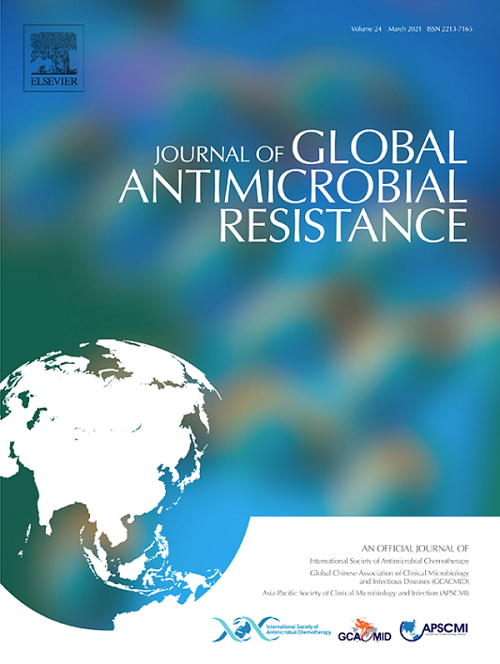Role of low-frequency integrase strand transfer inhibitor resistance mutations on virological outcomes in antiretroviral therapy-naïve individuals initiating second-generation integrase inhibitors
IF 3.7
3区 医学
Q2 INFECTIOUS DISEASES
引用次数: 0
Abstract
Objectives
This study investigated the role of low-frequency integrase strand transfer inhibitor (INSTI) resistance mutations, detectable by next-generation sequencing (NGS), at predicting virological rebound (VR) among people with HIV (PWH) starting second-generation INSTI-based first-line regimens.
Methods
This case-control study compared PWH (retrieved from the ICONA cohort; www.icona.org) who experienced VR (cases) with those who maintained virological control (controls) under first-line regimens based on dolutegravir or bictegravir. NGS data obtained through the Illumina platform were interpreted using the HIVdb algorithm version 9.7. Major (MRM), accessory (ARM), and other (ORM) INSTI resistance mutations were analysed at 5%, 10%, and 20% NGS cut-offs, respectively. Conditional logistic regression was used to evaluate the association between INSTI resistance and risk of VR.
Results
Among 266 PWH (90 cases, 176 controls), cases experienced VR with a median (interquartile range) viremia of 317 (93–6060) copies/mL after 15 (8–28) months from antiretroviral therapy start. The prevalence of MRM was low (NGS cut-off 5%, 10%, 20%: 1.9%, 0.8%, 0.4%, respectively), while it was moderate for ARM (7.5%, 7.1%, 6.4%) and high for ORM (50.0%, 44.7%, 42.1%). There was no evidence of a difference in prevalence of ≥1 MRM, ARM, or ORM between cases and controls. At 5% NGS cut-off, the prevalence of ≥2 ORM was higher in cases compared with controls. After adjusting for confounders, including HIV-1 subtype, ≥2 ORM detected as minority variants remained associated with VR risk.
Conclusion
Our findings suggest that combinations of low-frequency ORM may increase the risk of VR in individuals starting dolutegravir or bictegravir-based regimens. Further studies are needed to better understand these findings.
低频整合酶链转移抑制剂耐药突变对抗逆转录病毒therapy-naïve个体启动第二代整合酶抑制剂的病毒学结果的作用
目的:本研究探讨低频整合酶链转移抑制剂(INSTI)耐药突变(通过下一代测序(NGS)检测)在预测开始第二代基于INSTI的一线治疗的HIV (PWH)患者的病毒学反弹(VR)中的作用。方法本病例对照研究比较了来自ICONA队列的PWH;www.icona.org)与那些在基于多替格拉韦或比替格拉韦的一线方案下保持病毒学控制(对照)的人经历了VR(病例)。通过Illumina平台获得的NGS数据使用HIVdb算法9.7版本进行解释。主要(MRM)、辅助(ARM)和其他(ORM) INSTI耐药突变分别在5%、10%和20% NGS截止点进行分析。使用条件逻辑回归来评估INSTI抵抗与VR风险之间的关系。结果266例PWH患者(90例,对照组176例)在开始抗逆转录病毒治疗15(8-28)个月后出现病毒血症,中位数(四分位数范围)为317(93-6060)拷贝/mL。MRM的患病率较低(NGS临界值分别为5%、10%、20%、1.9%、0.8%、0.4%),而ARM的患病率中等(7.5%、7.1%、6.4%),ORM的患病率较高(50.0%、44.7%、42.1%)。没有证据表明病例和对照组之间MRM、ARM或ORM的患病率存在差异。在5% NGS截止点,病例中≥2 ORM的患病率高于对照组。在校正混杂因素(包括HIV-1亚型)后,作为少数变异检测到的≥2 ORM仍然与VR风险相关。结论:我们的研究结果表明,联合使用低频ORM可能会增加开始使用多替替韦或双替替韦的患者发生VR的风险。需要进一步的研究来更好地理解这些发现。
本文章由计算机程序翻译,如有差异,请以英文原文为准。
求助全文
约1分钟内获得全文
求助全文
来源期刊

Journal of global antimicrobial resistance
INFECTIOUS DISEASES-PHARMACOLOGY & PHARMACY
CiteScore
8.70
自引率
2.20%
发文量
285
审稿时长
34 weeks
期刊介绍:
The Journal of Global Antimicrobial Resistance (JGAR) is a quarterly online journal run by an international Editorial Board that focuses on the global spread of antibiotic-resistant microbes.
JGAR is a dedicated journal for all professionals working in research, health care, the environment and animal infection control, aiming to track the resistance threat worldwide and provides a single voice devoted to antimicrobial resistance (AMR).
Featuring peer-reviewed and up to date research articles, reviews, short notes and hot topics JGAR covers the key topics related to antibacterial, antiviral, antifungal and antiparasitic resistance.
 求助内容:
求助内容: 应助结果提醒方式:
应助结果提醒方式:


